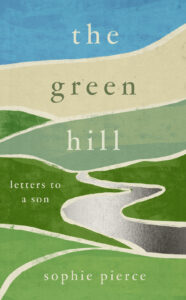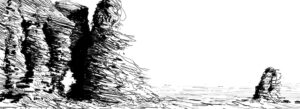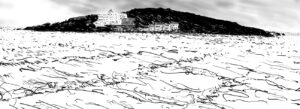In 2017, Sophie Pierce’s life changed forever when her twenty-year-old son Felix died suddenly and unexpectedly. Her book ‘The Green Hill’ is set amid the rivers and rocks of Dartmoor and the sea off the South Devon coast. It charts her journey through this trauma, showing the ways that engagement with the natural world helps us contend with our own mortality. With illustrations by Alex Murdin.

My friend Catherine and I meet in Teignmouth to swim at the Parson and Clerk. These are rock formations in the red cliffs by Parsons Tunnel, through which Brunel’s famous railway goes. The Parson protrudes from the end of the cliffs, with an archway through which you can swim. The Clerk is a small stack island (getting smaller every year) just off the shore. This coastline, with its terracotta cliffs, was created millions of years ago, when the area was a hot desert plain. The cliffs, being so old, feel, to me, like a graphic embodiment of time, and our place in it, something I have been thinking about so much since Felix died.
Catherine and I walk along the railway wall towards the northern end of the beach, which is where the rail line disappears into the tunnel. She naturally asks how I am, and I come out with a phrase that keeps rebounding around my head at the moment: ‘clinging to the wreckage’. I feel as though I’m hanging on by my fingernails to what I have left.
When, earlier, I’d looked at the webcam for Teignmouth, the water was looking flat calm, and perfect for a for a swim through the arch. I’ve had a couple of goes at this before but the sea has always been too rough to get through. However, in reality, when we get there today the sea is quite steely and choppy. The weather is all over the place – there are looming grey clouds and then bursts of sunshine.
Trains rumble by on the line behind us as we get changed. We wade into the water and then launch off into the chop. We are buffeted by the waves as we bounce along past the cliffs on our left, admiring their astonishingly bright red colour and their tufty green vegetation like unruly clumps of hair. We see a smart little oystercatcher, startling in black and white, standing sentinel on a rock.

We look up and see gulls in their nests in niches in the cliff above us. We pass the Clerk and approach the arch, magnificent and grand with its dramatic horizontal stripes of rock. We are unceremoniously bounced and tossed towards it by the wind and waves, and as we are swept through, we look up at its might overhead, and back through to the small phallic Clerk, framed by the opening. Once we are through to the other side, it’s like being in another place entirely. It is sheltered, and the sea is calm and a beautiful petrol-blue against the brick-red cliffs. We swim languidly, enjoying the flat water, and are heading towards a large cave when suddenly we catch sight of a big seal, about 200 yards away. That’s way too close in my book.
I have a bit of a history with seals. I remember the first time I encountered one in the water. I was with Anna at Hope Cove. We were swimming quite far into the bay at Inner Hope, aiming for a little island in the middle. I thought I saw something dark out of the corner of my eye but dismissed it. Then I felt something touch my leg – and I dismissed that too. Then, a couple of minutes later, a large, smooth head with huge, soulful eyes popped up right in front of us. My first thought was, Oh, wow, how wonderful to be so close to such a beautiful creature in its native habitat. But this quickly changed to panic when it leaned its head back, snorted through its very big nostrils and sank back into the sea, from where it was of course invisible and able to bump us without prior warning.
Ever since, I have given seals a wide berth, so Catherine and I turn tail and head back through the arch, and we find it is really hard going. Carelessly, we had not been paying attention when swimming out, and only now we realise that we were carried most of the way to the arch with little effort on our part. Now, we find heading back against the wind and current is really tough. Every time we make a stroke forward, we get pushed back by big waves. At one point I feel as though we aren’t making any progress at all, but try not to worry. Then, I find myself in a moment of not caring what happens. I indulge the feeling for a short while, then snap out of it and try to think what to do. We decide to give up trying to make a straight line back to the shore, and instead head for a nearby rock where we can get out and have a rest. We sit there for a while and then get back in; re-energised, we push back to the shore through the unfriendly swell.
It’s a relief to get back on dry land. We talk about what’s just happened. We were frightened, we got pretty cold, but at least we were out there, connecting with the elements, living. For me, at a very basic level, it was about distracting myself from the enormity of what has happened, putting myself at the mercy of the elements, and of nature, red in tooth and claw. To be perfectly honest, I didn’t care about putting myself in danger. I want to live really live, and I don’t mind if I die in the process.

*
Extracted from ‘The Green Hill: Letters to a Son’, out now and available here, published by Unbound.